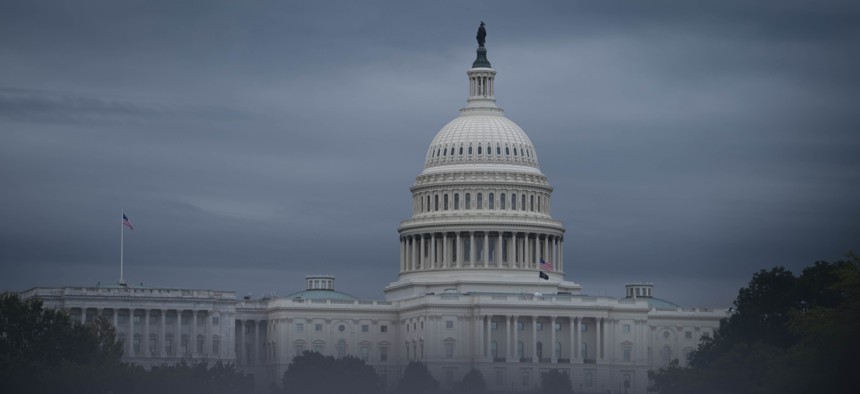
A report from the Center for Presidential Transition found that some Senate-confirmed agency officials could take more than 400 days to be confirmed. Bloomberg Creative / Getty Images
The Senate has too many appointees to confirm, and it's hurting agencies
There are too many layers of political officials requiring congressional approval, report finds.
Federal agencies are suffering from too many layers of political leadership, according to a new report that found the current process overwhelms the White House, overburdens the Senate and ultimately leads to less oversight of the executive branch.
The agencies throughout government that maintain up to five layers of Senate-confirmed political appointees are dealing with redundancy, a lack of clarity within senior roles and longstanding vacancies, the Center for Presidential Transition within the Partnership for Public Service said.
The Senate typically confirms the top two levels of political leadership at an agency—the secretary and deputy secretary of a major department, for example—within two months of a president’s inauguration, the study found. For third-level positions, that drops off to 350 days and fourth and fifth levels average more than 400 days.
The oversupply of confirmed political roles not only burdens the Senate and the White House, it also leaves vacancies in the positions that are the closest to operations. Those who temporarily step in, the center found, do not always perform the same duties as their permanent replacement.
“No matter how much energy and experience acting officials bring to a role, they may not feel empowered to make major decisions and legal challenges can arise when they do,” the group said. “Furthermore, employee engagement scores suggest that turnover and uncertainty can negatively impact workforce morale.”
It also “presents a challenge” to new presidents who want to quickly fill positions.
The State Department, not counting ambassadors, maintains the largest number of Senate-confirmed positions at 39. Twenty-six of those roles are at the fourth layer down the chain of command. The Defense Department has 17 assistant secretary or director positions requiring Senate confirmation that are five layers deep.
All told there are five agencies that have at least four layers of confirmed positions: the departments of State, Defense, Energy, Commerce and Treasury. Of the 68 bottom-level, Senate-confirmed roles at those agencies—including under, deputy and assistant secretaries—13% have never had a permanent individual fill them under President Biden.
A more cantankerous Congress, which demands more floor time for votes rather than unanimous or expedited approval, is also contributing to the problem. A previous review by the Partnership for Public Service found 58% of recorded votes in the Senate during Biden's first two years in office were on nominations. That figure was never more than 14% during the first two years under presidents Obama, George W. Bush, Clinton and George H.W. Bush.
At several agencies, the number of confirmed slots has grown in recent decades. Since 1992, State, Treasury and Defense have seen that total increase by 21, the transition center found. The group noted that congressionally led reorganizations of agencies, while well-intentioned, can create unnecessary bureaucratic layers.
The center stressed that agency responsibilities are growing and becoming more complex and the need to supply them with senior leaders is critical. The Senate does not have the capacity to provide oversight to the current number of positions it must confirm, however, and if some of that burden were lifted it could then spend more time reviewing candidates at the top two layers of each agency.
“Given the real delays and the importance of fulfilling an agency’s responsibilities well, does requiring Senate confirmation remain necessary and appropriate for each position if they are already overseen by at least two layers of Senate-confirmed leadership?” the group asked.
Instead, it proposed simply making more positions either political without requiring confirmation or reserving them for career executives. There are currently about 4,000 political positions in government, about 1,200 of which require Senate approval. Absent change, the center suggested, vacancies will persist and Congress will remain too overburdened to provide adequate oversight.
“Federal agencies need these leaders in place to best perform key functions for the people they serve and for Congress to conduct rigorous agency oversight,” it said.
NEXT STORY: Is it time to get rid of OPM?







